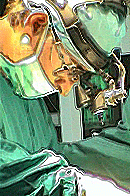Anaplastic
(Malignant) Astrocytoma
 The anaplastic astrocytoma is
intermediate in anaplasia between
astrocytoma and glioblastoma multiforme. In its common
location in the cerebral hemispheres of adults, it is also
intermediate in the age of highest incidence (40 to 50
years), duration of preoperative symptoms, and degree of
macroscopic abnormality. The lesion also occurs in the brain
stem and spinal cord.
The anaplastic astrocytoma is
intermediate in anaplasia between
astrocytoma and glioblastoma multiforme. In its common
location in the cerebral hemispheres of adults, it is also
intermediate in the age of highest incidence (40 to 50
years), duration of preoperative symptoms, and degree of
macroscopic abnormality. The lesion also occurs in the brain
stem and spinal cord.
 The increment of cellularity
over the well-differentiated astrocytoma
makes macroscopic abnormality more apparent, so that the
anaplastic astrocytoma is better defined from the
surrounding brain. Microscopically it is also more abnormal,
as the cells are more populous, more pleomorphic, and more
often present in mitotic division. The cells may invade the
cerebral cortex to surround neurons (perineuronal
satellitosis) and mass within a subpial position.
Cells with cytoplasmic features of astrocytes are often
prominent, but less well-differentiated cells may also be
seen. Absent is the necrosis that characterizes
glioblastoma multiforme, although vascular proliferation
may be seen in limited degrees.
The increment of cellularity
over the well-differentiated astrocytoma
makes macroscopic abnormality more apparent, so that the
anaplastic astrocytoma is better defined from the
surrounding brain. Microscopically it is also more abnormal,
as the cells are more populous, more pleomorphic, and more
often present in mitotic division. The cells may invade the
cerebral cortex to surround neurons (perineuronal
satellitosis) and mass within a subpial position.
Cells with cytoplasmic features of astrocytes are often
prominent, but less well-differentiated cells may also be
seen. Absent is the necrosis that characterizes
glioblastoma multiforme, although vascular proliferation
may be seen in limited degrees.
 The diagnosis of anaplastic
astrocytoma depends on the histological
distinction between well-differentiated astrocytoma on one
hand and glioblastoma multiforme on the other. The better
differentiated varieties of the anaplastic astrocytoma are
separated from the well-differentiated astrocytoma by
imprecise and subjective differences in cellularity and
pleomorphism. The criteria for distinguishing these two
lesions may therefore vary among observers, and the dividing
line may wander even in the same microscopist from
observation to observation. At the other extreme the
anaplasia of this lesion overlaps with that of
glioblastoma, and there is no well-established criterion to
separate these two lesions on the basis of cellularity or
anaplasia alone. As discussed below, the glioblastoma is
often diagnosed only when necrosis and/or vascular
proliferation are present. If one holds rigorously to this
rule, many glioblastomas will be underdiagnosed as
anaplastic astrocytomas in small specimens, such as needle
biopsies, that do not happen to include necrosis or vascular
proliferation. It is not surprising, therefore, that some
patients with "anaplastic astrocytomas" in the cerebral
hemispheres do not survive for the 2 years expected for such
patients.
The diagnosis of anaplastic
astrocytoma depends on the histological
distinction between well-differentiated astrocytoma on one
hand and glioblastoma multiforme on the other. The better
differentiated varieties of the anaplastic astrocytoma are
separated from the well-differentiated astrocytoma by
imprecise and subjective differences in cellularity and
pleomorphism. The criteria for distinguishing these two
lesions may therefore vary among observers, and the dividing
line may wander even in the same microscopist from
observation to observation. At the other extreme the
anaplasia of this lesion overlaps with that of
glioblastoma, and there is no well-established criterion to
separate these two lesions on the basis of cellularity or
anaplasia alone. As discussed below, the glioblastoma is
often diagnosed only when necrosis and/or vascular
proliferation are present. If one holds rigorously to this
rule, many glioblastomas will be underdiagnosed as
anaplastic astrocytomas in small specimens, such as needle
biopsies, that do not happen to include necrosis or vascular
proliferation. It is not surprising, therefore, that some
patients with "anaplastic astrocytomas" in the cerebral
hemispheres do not survive for the 2 years expected for such
patients.


